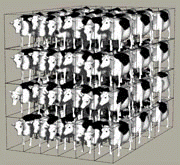Animal Science, Department of
Date of this Version
1986
Abstract
The Land Development and Management Corporation (LDMC) has estabished an open-nucleus Breeding Scheme within its Rotorua District to breed Angus bulls to cover 20 750 cows and 5 200 heifers. Nucleus herd numbers over the 1976-85 period were 775 cows and 357 heifers, with an average of 101 2-year-old bulls being distributed annually to LDMC herds. From 1976/77, a multiplicative breeding objective was established in the nucleus, accounting for cow and calf weights and net fertility of the cow. Primary selection was applied to yearling bulls and heifers using a selection index combining the calf's data and dam's updated data ('Yearling Index', YI). For calves born in 1976 to 1984, the average generation interval was 3.76 years. The corresponding cumulative selection differential for YI had reached 1.90σ in the final year, with similar values also for three of four component traits. For young males, the actual selection differential for YI was 1.47σ, 86% of the maximum possible. The selection applied in this industry Scheme was comparable with that recently reported in two large long-term experimental selection herds of beef cattle.


Comments
Published in 3rd World Congress on Genetics Applied to Livestock Production, edited by Gordon E. Dickerson and Rodger K. Johnson, 4 vols. (Lincoln: University of Nebraska Institute of Agriculture and Natural Resources, 1986). Copyright © 1986 Board of Regents University of Nebraska.